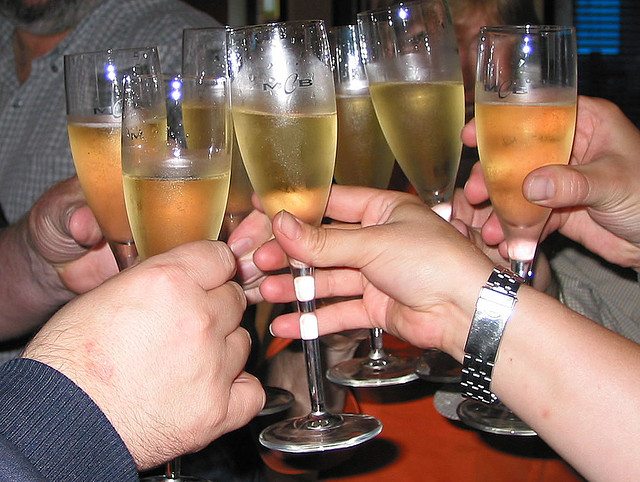

This work is licensed under a Creative Commons Attribution-NonCommercial-ShareAlike 2.0 Generic License.
Ironically, the cheerful clinking of glasses before drinking evolved from one of the darker practices of distant history. The custom dates back to the Middle Ages, when people were so distrustful of one another that they weren’t above poisoning anyone they perceived as an enemy. As a safeguard, drinkers first poured a bit of wine into each other’s glass, acting as mutual “tasters.” Trustworthy friends, however, soon dispensed with the tastings and merely clinked their glasses instead. This custom is said by some to explain why “to your health” is the most common toast worldwide. Some other historians hold that clinking glasses provided the noise that would keep evil spirits at bay.
So, where does the word “toast” come from? In the ale houses of Elizabethan England, a bit of spiced toast was usually put in the bottom of a cup of ale or wine to flavor it, and possibly to soak up the dregs. In time, any male or female whose qualities or accomplishments were frequently honored with a group drink came to be called “toasts” (hence the phrase “toast of the town”). One story-attributed, in a 1706 edition of The Tatler, to “many Wits of the last Age”-claimed that “toast” was first used in this manner during the reign of Charles II (1660-1684).That label, it was said, was bestowed on a well-known belle from the town of Bath. As the beauty luxuriated in the healthful waters of the public baths, an admiring gentleman scooped a little bath water into a cup, added the customary piece of toast, and raised the cupful of water to her before drinking it.
The word “toast” as used today, “a sentiment expressed just before drinking to someone”, did not begin to gain popularity until the early 1700s.
From Emily Post’s Etiquette, 17th Edition by Peggy Post. This book has a comprehensive wedding etiquette section as well as a general etiquette information we can all use in our everyday lives. It’s a book that should be on every shelf. HarperCollins Publishers. Used by permission. Find more Wedding Toasts and Speeches here.

